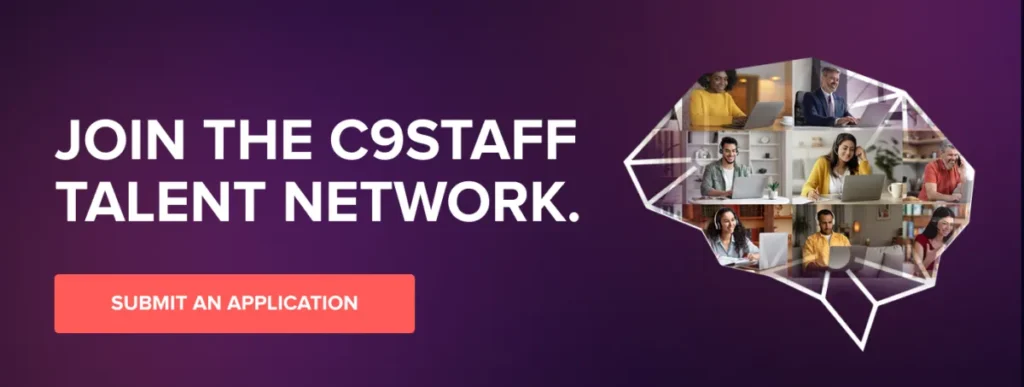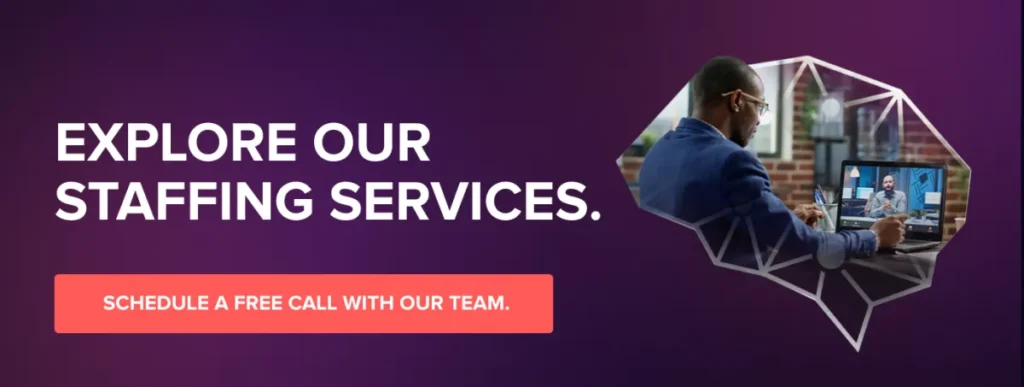Introduction

Visualize you’re addressing a room full of aspiring corporate trainers and seasoned business leaders. Your goal is to captivate them from the very first sentence. The importance of a meticulously crafted corporate trainer job description cannot be overstated. This document is more than mere administrative paperwork; it is a pivotal tool that shapes the path of careers and the success of organizations. As we delve into this guide, we will explore the comprehensive roles and responsibilities of a corporate trainer and outline how these elements impact both potential candidates and employers alike.
If your goal is to find the best job description template on the market, suitable for crafting your own hiring specifications with precision and effectiveness, we have exactly what you need. Follow the link provided below to access our complimentary Retention Specialist Job Description. This document embodies the core principles and best practices of C9Staff’s renowned hiring methodology, providing you with a robust foundation to attract and retain top talent. Simply copy and paste the link into your browser to begin using a proven template that sets the stage for hiring success.
Corporate Trainer Job Description Template

A corporate trainer is not just a teacher or an educator within a company, but a transformative figure who can significantly uplift organizational performance and culture. Through effective training strategies, a corporate trainer ensures that employees are not only well-versed in their current roles but are also primed for future challenges, embodying the company’s values and vision. This introduction serves as your gateway into understanding how a well-defined job description is fundamental in attracting and cultivating talent that aligns perfectly with your organizational goals and culture.
Let us board on this journey to uncover the essential components of a corporate trainer job description. By the end of this article, you will see how integral a skilled corporate trainer is to fostering an environment of continuous improvement and innovation. Whether you aim to step into this transformative role or seek to hire a candidate who can bring about substantial organizational change, this guide will provide you with the necessary insights to make informed decisions. Get ready to transform the way you think about corporate training and its profound impact on company success.
Behind the Success: Unveiling the Impact of a Corporate Trainer
Understanding the Role of a Corporate Trainer

As we transition from the engaging introduction of “Mastering the Role: The Ultimate Guide to Corporate Trainer Job Descriptions,” let’s delve deeply into the essence of what defines a corporate trainer. A corporate trainer plays a critical role, not just in delivering training but in shaping the growth trajectory of employees and the broader success of their organization.
Primary Responsibilities of a Corporate Trainer
The core responsibilities of a corporate trainer encompass a variety of duties, central to which is the design and delivery of effective training programs. Daily, trainers assess the needs of the business to develop customized training solutions that align with organizational goals. They conduct workshops, seminars, and one-on-one coaching sessions, each aimed at enhancing employee skills and knowledge. Moreover, trainers continuously evaluate the effectiveness of their programs, making adjustments to optimize learning outcomes and ensure they meet the evolving demands of the workplace.
The impact of these responsibilities stretches far beyond routine education; they are instrumental in fostering professional development and promoting a culture of continuous learning and improvement. By equipping employees with the necessary tools and knowledge, trainers directly contribute to the operational efficiency and strategic success of their organizations.
Essential Skills and Competencies
To excel in this role, a corporate trainer must possess a specific set of skills and competencies:
Communication: Paramount for trainers, effective communication ensures that information is not only delivered but also understood and applied by all participants, regardless of their learning styles.
Leadership: Trainers often serve as leaders, not just educators. Their ability to inspire and motivate is crucial in making training sessions engaging and transformative.
Technical Proficiency: In today’s digital age, being adept with the latest educational technologies and platforms is indispensable for creating interactive and impactful training environments.
Consider the scenario of a trainer who used augmented reality tools to simulate customer service challenges, allowing employees to practice their responses in real-time. Such innovative applications of technical skills not only make learning more engaging but also significantly enhance the retention and application of knowledge.
Work Environment and Team Dynamics
The typical work environment for a corporate trainer is dynamic and requires adaptability to various team structures and organizational cultures. Trainers often find themselves navigating diverse workgroups and adjusting their methods to fit different cultural norms and expectations within the company. This flexibility is crucial in creating an inclusive atmosphere that respects and utilizes the diverse backgrounds and experiences of all employees, promoting an environment where everyone can learn and contribute effectively.
The ability of a corporate trainer to integrate seamlessly into these dynamics can dramatically influence the productivity and harmony of the work environment, making their role pivotal in building a cohesive team.
Crafting the Perfect Job Description: A Guide for Employers

As we progress from understanding the comprehensive role of a corporate trainer, it is crucial for you, the employer, to master the art of crafting a job description that not only captures the essence of the position but also aligns seamlessly with your organizational goals. This part of our guide is dedicated to helping you draft a job description that resonates with the best candidates and reflects your company’s strategic ambitions.
Key Components of a Corporate Trainer Job Description
Every effective job description begins with clear and specific information that outlines what the company expects from the candidate and what the candidate can expect from the company. Essential elements to include are:
Job Title: This should be precise and reflective of the role and level of seniority.
Responsibilities: List the day-to-day tasks and long-term expectations. Be explicit about what the role entails to avoid any ambiguities.
Required Qualifications: Specify educational backgrounds, certifications, and experience needed.
Preferred Skills: Highlight skills that would enhance a candidate’s success in the role, such as leadership, communication, and technical skills.
Clarity and specificity in these areas are not just beneficial; they are essential in attracting the most qualified applicants. A well-drafted job description acts as a filter that ensures only those truly fit for the role will apply, saving you time and resources in the recruitment process.
Aligning Job Descriptions with Strategic Objectives
To ensure that every new hire moves your company closer to its overarching ambitions, integrate your vision, mission, and values into the job description. This alignment helps prospective candidates understand not just what you expect of them, but also what they can expect of you as an employer—a critical factor in attracting individuals who share your organizational values and are more likely to commit long-term.
For example, if your company prides itself on innovation and continuous improvement, highlight how the role of a corporate trainer is pivotal in fostering a culture of learning and development that supports these values. This way, you attract candidates who are not only capable of performing the job but are also aligned with the spirit of your company.
Benchmarking and Competitive Advantage
In today’s competitive job market, staying abreast of industry standards and benchmarks is crucial. Use these standards to inform your job descriptions and ensure that the terms of employment you offer can compete with or exceed those of your rivals. This includes everything from salary to professional development opportunities to work-life balance initiatives.
Regularly update your job descriptions based on new industry trends. For instance, if there’s a growing demand for corporate trainers who are proficient in digital training tools, include this requirement in your job description to attract forward-thinking candidates who can bring fresh perspectives and skills to your team.
If your goal is to find the best job description template on the market, suitable for crafting your own hiring specifications with precision and effectiveness, we have exactly what you need. Follow the link provided below to access our complimentary Retention Specialist Job Description. This document embodies the core principles and best practices of C9Staff’s renowned hiring methodology, providing you with a robust foundation to attract and retain top talent. Simply copy and paste the link into your browser to begin using a proven template that sets the stage for hiring success.
Corporate Trainer Job Description Template

For Candidates - Interpreting Job Descriptions

As you, the aspiring corporate trainers or those aiming to progress in this vibrant field, continue your career journey, understanding how to navigate and interpret job descriptions is crucial. This section will equip you with the skills to decode job postings effectively, align your experiences to meet the outlined requirements, and strategically prepare for interviews.
Decoding Job Descriptions
The first step in your job application process is to decode the job description thoroughly. Each part of the job description, from the required qualifications to the responsibilities and preferred skills, holds vital information about what the employer values most. Pay close attention to key phrases and terminology—terms like “team player,” “leadership,” or “hands-on training” aren’t just filler text; they signify essential qualities the employer is seeking. By understanding these nuances, you can gauge the suitability of the position relative to your skills and career goals. For instance, a job description emphasizing “innovative thinking and leadership in a dynamic environment” suggests a role that values proactive, strategic individuals who are comfortable leading change.
Aligning Your Skills and Experiences
With a clear understanding of the job description, the next step is to align your resume and cover letter accordingly. Highlight your experiences that directly relate to the top requirements of the job description. For example, if the job emphasizes the need for “effective training delivery,” include specific examples of your training sessions, the methodologies you used, and the feedback or outcomes that demonstrate your success. Even if some of your relevant experiences come from non-traditional roles, such as volunteering or hobbies that involve coaching or teaching, these can showcase transferable skills critical for a corporate trainer.
Preparing for Interviews
The job description should also be your guide for interview preparation. Use it to anticipate potential interview questions and the themes you might encounter. For example, if the job description highlights the importance of “adapting training methods to diverse audiences,” be prepared to discuss how you’ve tailored training sessions in the past to accommodate varied learner needs. Additionally, develop questions that you can ask the interviewer that demonstrate your deep understanding of the company’s goals and culture. This not only shows your interest and initiative but also your alignment with the company’s direction.
By mastering the art of interpreting job descriptions, you position yourself not just to land an interview but to secure a role that aligns perfectly with your career aspirations and enhances your professional growth. As we progress to the next section on integration strategies for both candidates and employers, keep in mind how the insights from job descriptions are not merely for application purposes but are integral to your ongoing professional development and successful integration into your new role.
If you’re ready to supercharge your career and land your dream job, C9Staff is here to help make that happen. We invite you to click the link below and submit your resume to our talent acquisition department. Should your qualifications align with our client requirements, we will be in touch to explore potential opportunities that match your profile. Don’t miss the chance to advance your career with a role perfectly suited to your skills and ambitions. Submit your resume today and let us connect you with your next great opportunity!

Integration Strategies for Both Audiences
In the dynamic field of corporate training, both employers and candidates have pivotal roles to play. This section bridges the gap between these two groups, offering strategic insights gleaned from corporate trainer job descriptions to enhance recruitment efficacy and support career progression. Here, we address each group directly, providing tailored strategies that meet your unique needs and perspectives.
For Employers: Refining Job Descriptions through Trainer Feedback
A key strategy for employers is the integration of feedback from current corporate trainers into the refinement of job descriptions. This practice ensures that the descriptions not only reflect the actual demands and challenges of the role but also remain aligned with the evolving needs of your organization and the industry at large.
Consider, for example, a scenario where trainers highlight a growing need for expertise in virtual training platforms due to increased remote work. Incorporating this feedback into job descriptions can help clarify role expectations and improve the accuracy of required qualifications and skills, thereby attracting candidates who are genuinely equipped to meet contemporary challenges.
Regularly soliciting and utilizing input from your training staff can also prevent discrepancies between job expectations and reality, which often leads to better retention rates and overall job satisfaction among new hires. Such engagement shows that you value the insight and experience of your existing team, fostering a more inclusive and collaborative workplace culture.
For Candidates: Engaging in Continuous Skill Development
Candidates, on the other hand, should focus on continuous skill development to align with emerging trends highlighted in job descriptions. Staying proactive in learning new skills and technologies is crucial as it ensures that your qualifications remain competitive in a rapidly evolving job market.
For instance, if you notice an increasing demand for skills in digital analytics within training roles, you might consider enrolling in relevant courses or workshops to acquire these competencies. Keeping abreast of such trends can be facilitated by subscribing to industry newsletters, joining professional training associations, or participating in relevant forums and webinars.
By continuously updating your skills in response to the demands outlined in job descriptions, you not only enhance your employability but also position yourself as a forward-thinking candidate who is prepared to contribute effectively from the start.
Top 6 Essential Skills Every Corporate Trainer Needs to Master
Future Trends in Corporate Training
As we gaze into the horizon of corporate training, it is clear that the field is undergoing a rapid transformation, driven by technological advancements, the emergence of new skill sets, and global trends. This section explores these developments and provides insights into how they will reshape the roles and responsibilities of corporate trainers, preparing you to navigate and lead in this evolving landscape.
Technological Advancements
The integration of digital tools and artificial intelligence (AI) into corporate training is revolutionizing how training programs are designed, implemented, and evaluated. Virtual reality (VR) offers immersive training environments that simulate real-world scenarios, allowing trainees to practice skills in a controlled, yet realistic setting. AI is personalizing learning experiences by adapting content to the learner’s pace and needs, enhancing engagement and retention. Moreover, advanced analytics are becoming crucial in measuring training effectiveness, providing trainers with precise feedback on what works and what needs improvement. These technologies not only enhance learning outcomes but also demand that trainers possess tech-savvy skills to effectively integrate these tools into their methodologies.
Evolving Skill Sets
The skill sets required for corporate trainers are also evolving. In an increasingly automated and global workplace, adaptability, digital literacy, and data-driven decision-making are becoming paramount. Trainers need to be agile, ready to adopt new technologies, and capable of interpreting data to make informed decisions about training strategies. For example, a trainer might need to learn how to use predictive analytics to tailor training programs to anticipated changes in the workforce. Professional development courses in emerging technologies, as well as self-directed learning platforms, can be valuable resources for trainers aiming to stay at the cutting edge of their profession.
Global Perspectives
International trends are significantly influencing job descriptions for corporate trainers. As companies become more global, trainers must be able to manage and deliver training across diverse cultural landscapes. This includes developing cultural competence, understanding global compliance standards, and being able to conduct training sessions that cater to culturally diverse audiences or remote workforces. The ability to manage cross-cultural teams and navigate international collaborations is increasingly essential, requiring trainers to be versed in global educational standards and sensitive to cultural nuances.
Navigating the Future
As both an employer and a candidate in the field of corporate training, staying informed about these trends is not just beneficial—it is essential for survival and success. Embracing these changes and preparing for the future will position you or your organization at the forefront of training innovation.
If you’re looking to enhance your team with the perfect fit for a Retention Specialist, C9Staff is here to guide you every step of the way—from sourcing to deployment. We invite you to click the link below and schedule a free exploratory call with one of our account managers today. During this call, we’ll listen attentively to your needs and provide endorsements for potential candidates at no cost, helping you evaluate the best talent available at competitive prices. Take the first step towards optimizing your workforce with C9Staff’s comprehensive support.

Conclusion: Mastering the Art of Corporate Trainer Job Descriptions
As we wrap up this comprehensive exploration of corporate trainer job descriptions, let us take a moment to reflect on the key insights and strategies discussed throughout this article. This journey has underscored the importance of well-crafted job descriptions and how they shape the effectiveness of corporate trainers, ultimately impacting organizational success.
Recap of Key Points
Understanding the Role: We started by defining the core responsibilities, necessary skills, and typical work environments of corporate trainers. Understanding these elements is crucial for both employers crafting job descriptions and candidates evaluating their fit.
For Employers: We emphasized the importance of crafting precise and strategic job descriptions that align with business goals and maintain a competitive advantage. A thoughtful job description attracts the right candidates and sets clear expectations that benefit both parties.
For Candidates: The importance of accurately interpreting job descriptions cannot be overstated. Candidates must align their skills with job requirements and prepare effectively for interviews, using the job description as a roadmap to showcase their qualifications.
Integration Strategies: We discussed how both employers and candidates can utilize feedback and continuous skill development to adapt to the changing demands of corporate training, ensuring relevance and efficacy in their roles.
Future Trends: Finally, we explored how technological advancements, evolving skill sets, and global perspectives will influence the roles of corporate trainers moving forward. These trends demand that both employers and candidates remain agile and forward-thinking.
Employers are encouraged to take these insights and craft job descriptions that are not only thorough but also reflective of the evolving needs of their organizations. Meanwhile, candidates should approach these descriptions strategically, using them as tools to showcase their qualifications and prepare for future career opportunities.
The dynamic and essential role of corporate trainers in fostering both organizational and personal growth cannot be overstated. Through thoughtful job description crafting and strategic career planning, corporate trainers are uniquely positioned to enhance their impact on organizational success and personal career trajectories.
As we conclude, let us reaffirm that the role of the corporate trainer is pivotal to the continuous learning and adaptation necessary in today’s fast-paced, ever-evolving business environments. Embracing these roles and responsibilities can lead to profound transformations, not just within organizations but also in the personal lives of those involved. Reflect on how adopting these insights can propel your personal and professional growth to new heights.




